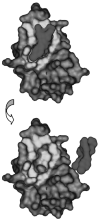Targeting the p53-MDM2 interaction to treat cancer
- PMID: 15452548
- PMCID: PMC2409943
- DOI: 10.1038/sj.bjc.6602164
Targeting the p53-MDM2 interaction to treat cancer
Abstract
The tumour suppressor p53 is a transcription factor with powerful antitumour activity that is controlled by its negative regulator MDM2 (mouse double minute 2, also termed HDM2 in humans) through a feedback mechanism. MDM2, which is overproduced in many tumours, binds p53 and inhibits its function by modulating its transcriptional activity and stability. Activation of p53 in tumour cells by inhibiting its physical interaction with MDM2 has been in the focus of cancer drug discovery. However, development of nonpeptidic MDM2 antagonists turned out to be challenging. Recently, the first potent and selective small-molecule antagonists of MDM2, the Nutlins, have been identified. Studies with Nutlins provided in vitro and in vivo proof-of-principle for targeting p53-MDM2 interaction for cancer therapy.
Figures


Similar articles
-
Inhibition of the p53-MDM2 interaction: targeting a protein-protein interface.Mol Cancer Res. 2004 Jan;2(1):20-8. Mol Cancer Res. 2004. PMID: 14757842 Review.
-
Small-molecule antagonists of p53-MDM2 binding: research tools and potential therapeutics.Cell Cycle. 2004 Apr;3(4):419-21. Epub 2004 Apr 1. Cell Cycle. 2004. PMID: 15004525
-
A nonpeptidic sulfonamide inhibits the p53-mdm2 interaction and activates p53-dependent transcription in mdm2-overexpressing cells.J Med Chem. 2004 Aug 12;47(17):4163-5. doi: 10.1021/jm034182u. J Med Chem. 2004. PMID: 15293988
-
Small-molecule inhibitors of the p53-HDM2 interaction for the treatment of cancer.Expert Opin Investig Drugs. 2008 Dec;17(12):1865-82. doi: 10.1517/13543780802493366. Expert Opin Investig Drugs. 2008. PMID: 19012502 Review.
-
Inhibition of the p53-hdm2 interaction with low molecular weight compounds.Cell Cycle. 2004 Apr;3(4):460-1. doi: 10.4161/cc.3.4.791. Epub 2004 Apr 1. Cell Cycle. 2004. PMID: 14976429
Cited by
-
The Role of p53 Expression in Patients with RAS/BRAF Wild-Type Metastatic Colorectal Cancer Receiving Irinotecan and Cetuximab as Later Line Treatment.Target Oncol. 2021 Jul;16(4):517-527. doi: 10.1007/s11523-021-00816-3. Epub 2021 May 10. Target Oncol. 2021. PMID: 33970400 Free PMC article.
-
Regulation of GAD65 expression by SMAR1 and p53 upon Streptozotocin treatment.BMC Mol Biol. 2012 Sep 14;13:28. doi: 10.1186/1471-2199-13-28. BMC Mol Biol. 2012. PMID: 22978699 Free PMC article.
-
Efficient Generation and Correction of Mutations in Human iPS Cells Utilizing mRNAs of CRISPR Base Editors and Prime Editors.Genes (Basel). 2020 May 6;11(5):511. doi: 10.3390/genes11050511. Genes (Basel). 2020. PMID: 32384610 Free PMC article.
-
Novel targeted therapeutics: inhibitors of MDM2, ALK and PARP.J Hematol Oncol. 2011 Apr 20;4:16. doi: 10.1186/1756-8722-4-16. J Hematol Oncol. 2011. PMID: 21504625 Free PMC article. Review.
-
Positional effects of click cyclization on β-hairpin structure, stability, and function.Org Biomol Chem. 2013 Jan 7;11(1):69-77. doi: 10.1039/c2ob26445e. Org Biomol Chem. 2013. PMID: 23064223 Free PMC article.
References
-
- Arkin MR, Wells JA (2004) Small-molecule inhibitors of protein–protein interactions: progressing towards the dream. Nat Rev Drug Discov 3: 301–317 - PubMed
-
- Blaydes JP, Gire V, Rowson JM, Wynford-Thomas D (1997) Tolerance of high levels of wild-type p53 in transformed epithelial cells dependent on auto-regulation by mdm-2. Oncogene 14: 1859–1868 - PubMed
-
- Blommers MJJ, Fendrich G, Garcia-Echeverria C, Chene P (1997) On the interaction between p53 and MDM2: Transfer NOE study of a p53-derived peptide ligated to MDM2. J Am Chem Soc 119: 3425–3426
-
- Bottger A, Bottger V, Garcia-Echeverria C, Chene P, Hochkeppel HK, Sampson W, Ang K, Howard SF, Picksley SM, Lane DP (1997a) Molecular characterization of the hdm2–p53 interaction. J Mol Biol 269: 744–756 - PubMed
-
- Bottger A, Bottger V, Sparks A, Liu WL, Howard SF, Lane DP (1997b) Design of a synthetic Mdm2-binding mini protein that activates the p53 response in vivo. Curr Biol 7: 860–869 - PubMed
Publication types
MeSH terms
Substances
LinkOut - more resources
Full Text Sources
Other Literature Sources
Molecular Biology Databases
Research Materials
Miscellaneous

